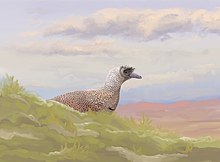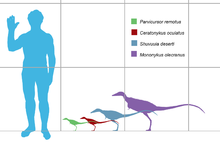Parvicursor
| Parvicursor Temporal range:
Late Cretaceous, | |
|---|---|

| |
| A reconstruction of Parvicursor sitting on a nest | |
| Scientific classification | |
| Domain: | Eukaryota |
| Kingdom: | Animalia |
| Phylum: | Chordata |
| Clade: | Dinosauria |
| Clade: | Saurischia |
| Clade: | Theropoda |
| Family: | †Alvarezsauridae |
| Subfamily: | †Parvicursorinae |
| Genus: | †Parvicursor Karhu & Rautian, 1996 |
| Species: | †P. remotus
|
| Binomial name | |
| †Parvicursor remotus Karhu & Rautian, 1996
| |
| Synonyms | |
| |
Parvicursor (meaning "small runner") is a genus of tiny maniraptoran dinosaur with long slender legs for fast running.[3]
Description
At only about 39 centimetres (15 in; 1.28 ft) from snout to end of tail, and 162 g (5.7 oz) in weight, it was initially seen as one of the smallest non-avian dinosaurs known from an adult specimen.[4] However, in 2022 its holotype was concluded to represent a juvenile individual.[1]

Like other members of the family Alvarezsauridae, the forelimbs of Parvicursor were short and stubby, with hands all but completely reduced to a single large claw, possibly useful for opening tough termite mounds or other types of digging. It is unlikely that the claw could have served much for defense, as it was short and not adapted for flexible movements — it is more likely it would do as the animal's name implies: cursor means runner.
Parvicursor is known from the late Campanian-age Barun Goyot Formation of Khulsan, Mongolia, dated at approximately 72 million years old. The type species, Parvicursor remotus, is only known from one incomplete specimen, holotype PIN no. 4487/25, mostly consisting of vertebrae, the pelvis and the right hindlimb, that was discovered in 1992 and described in 1996.[5] Close relatives include Shuvuuia and Mononykus, and together with these it is classified in the alvarezsaurid subfamily Parvicursorinae.
Taxonomy
There may be a second, yet-unnamed, species of Parvicursor. Two specimens of tiny alvarezsaurids were described by Suzuki et al. in 2002. These authors considered the specimens to be juvenile Shuvuuia, which lived in the same formation.[6] However, a study by Nick Longrich and Phil Currie in 2009 suggested that several characters of the skeleton, including fused wrist and pelvic bones, indicated that these specimens were in fact adults of a tiny alvarezsaurid species. A phylogenetic analysis found that they grouped together with Parvicursor, and the authors provisionally referred them to Parvicursor sp. pending further study.[7]
It has been suggested that Linhenykus and Ceratonykus may be junior synonyms of Parvicursor.[2][1]
Phylogeny
Parvicursor in a cladogram after Fowler et al. (2020):[8]
References
- ^ a b c Averianov AO, Lopatin AV (2022). "A re-appraisal of Parvicursor remotus from the Late Cretaceous of Mongolia: implications for the phylogeny and taxonomy of alvarezsaurid theropod dinosaurs". Journal of Systematic Palaeontology. 19 (16): 1097–1128. doi:10.1080/14772019.2021.2013965. S2CID 247222017.
- ^ a b Dyke, G. J.; Naish, D. (2011). "What about European alvarezsauroids?". Proceedings of the National Academy of Sciences. 108 (22): E147. Bibcode:2011PNAS..108E.147D. doi:10.1073/pnas.1101602108. PMC 3107280. PMID 21540333.
- ^ Parvicursor from Palaeos (technical)
- ^ Which was the smallest dinosaur? Archived 2011-07-06 at the Wayback Machine Royal Tyrrell Museum. Last accessed 2008-05-23.
- ^ Karhu, A.A. and Rautian, A.S. (1996). "A new family of Maniraptora (Dinosauria: Saurischia) from the Late Cretaceous of Mongolia". Paleontological Journal Russian Academy of Sciences 30(5): 583-592.
- ^ Suzuki, S.; Chiappe, L.M.; Dyke, G.J.; Watabe, M.; Barsbold, R.; Tsogtbaatar, K. (2002). "A new specimen of Shuvuuia deserti Chiappe, et al. 1998 from the Mongolian Late Cretaceous with a discussion of the relationships of alvarezsaurids to other theropod dinosaurs". Contributions in Science, Natural History Museum of Los Angeles County. 494: 1–18.
- ^ Longrich, Nicholas R.; Currie, Philip J. (2009). "Albertonykus borealis, a new alvarezsaur (Dinosauria: Theropoda) from the Early Maastrichtian of Alberta, Canada: Implications for the systematics and ecology of the Alvarezsauridae". Cretaceous Research. 30 (1): 239–252. doi:10.1016/j.cretres.2008.07.005.
- ^ Denver W. Fowler; John P. Wilson; Elizabeth A. Freedman Fowler; Christopher R. Noto; Daniel Anduza; John R. Horner (2020). "Trierarchuncus prairiensis gen. et sp. nov., the last alvarezsaurid: Hell Creek Formation (uppermost Maastrichtian), Montana". Cretaceous Research. 116: Article 104560. doi:10.1016/j.cretres.2020.104560. S2CID 225630913.









